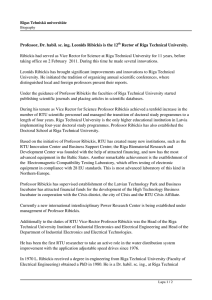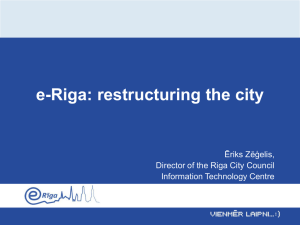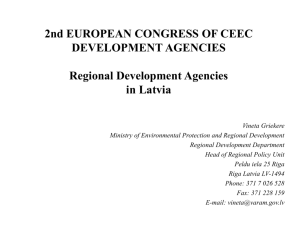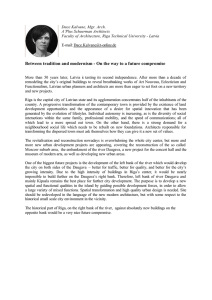Environmental Simulation
advertisement
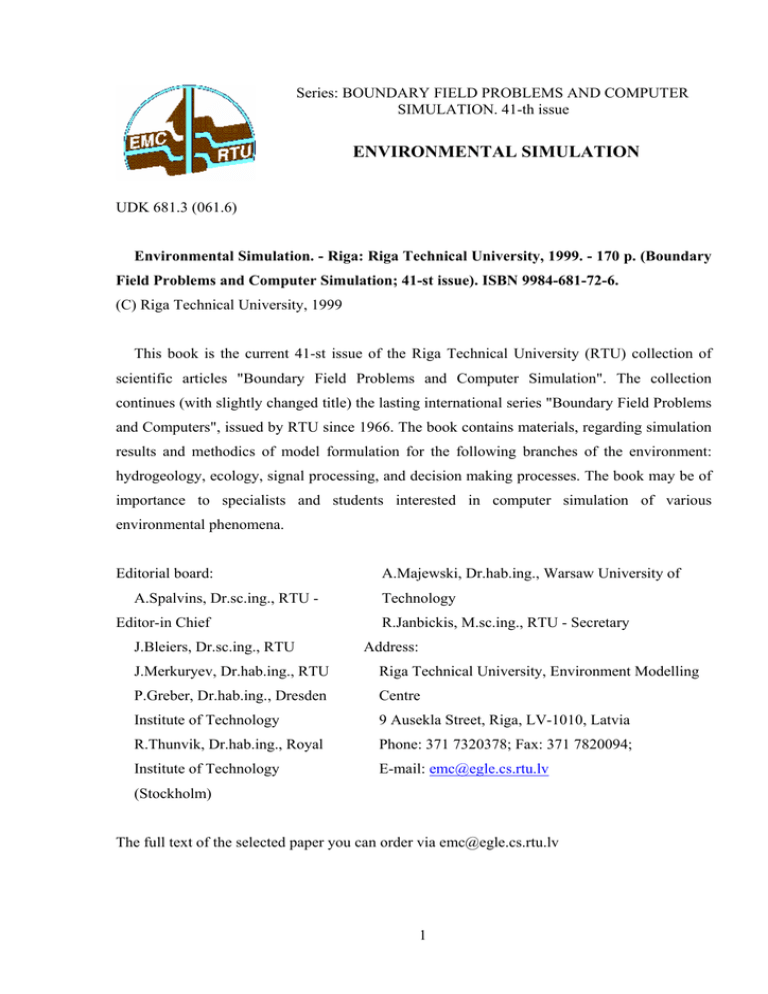
Series: BOUNDARY FIELD PROBLEMS AND COMPUTER SIMULATION. 41-th issue ENVIRONMENTAL SIMULATION UDK 681.3 (061.6) Environmental Simulation. - Riga: Riga Technical University, 1999. - 170 p. (Boundary Field Problems and Computer Simulation; 41-st issue). ISBN 9984-681-72-6. (C) Riga Technical University, 1999 This book is the current 41-st issue of the Riga Technical University (RTU) collection of scientific articles "Boundary Field Problems and Computer Simulation". The collection continues (with slightly changed title) the lasting international series "Boundary Field Problems and Computers", issued by RTU since 1966. The book contains materials, regarding simulation results and methodics of model formulation for the following branches of the environment: hydrogeology, ecology, signal processing, and decision making processes. The book may be of importance to specialists and students interested in computer simulation of various environmental phenomena. Editorial board: A.Spalvins, Dr.sc.ing., RTU Editor-in Chief J.Bleiers, Dr.sc.ing., RTU A.Majewski, Dr.hab.ing., Warsaw University of Technology R.Janbickis, M.sc.ing., RTU - Secretary Address: J.Merkuryev, Dr.hab.ing., RTU Riga Technical University, Environment Modelling P.Greber, Dr.hab.ing., Dresden Centre Institute of Technology 9 Ausekla Street, Riga, LV-1010, Latvia R.Thunvik, Dr.hab.ing., Royal Phone: 371 7320378; Fax: 371 7820094; Institute of Technology E-mail: emc@egle.cs.rtu.lv (Stockholm) The full text of the selected paper you can order via emc@egle.cs.rtu.lv 1 Contents Abstracts ....................................................................................................................................... 4 Z. Otremba SELECTED RESULTS OF LIGHT FIELD MODELING ABOVE THE SEA SURFACE COVERED BY THIN OIL FILM ........................................................ 4 E. Stalidzans1 and A. Berzonis2 ANALYTICAL DEVELOPMENT MODEL OF BEE COLONY ......................................................................................................................... 4 M. Gregorauskas, GROUNDWATER A. Klimas FLOW and AND A. Bendoraitis CONTAMINANT A MODEL OF TRANSPORT AT KLAIPEDA OIL TERMINAL, LITHUANIA ......................................................................... 5 A. Spalvins1, R. Janbickis1, J. Slangens1, I. Lace1, I. Eglite1, A. Marcinonis2 and A. Stuopis2 MODELLING OF DISSOLVED HYDROCARBON MIGRATION AT AREA OF VILNIUS OIL STORAGE, LITHUANIA ............................... 5 A. Spalvins1, J. Slangens1, R. Janbickis1, I. Lace1, V. Skibelis1, E. Gosk2, O. Aleksans3 and I. Semjonovs4 CREATING OF REGIONAL AND LOCAL HYDROGEOLOGICAL MODELS FOR WASTE DEPOSIT POOLS IN INCUKALNS, LATVIA........................................................................................................... 6 RATIONAL PREPROCESSING OF INITIAL DATA ENABLES TO CREATE CREDIBLE HYDROGEOLOGICAL MODELS..................................................................... 6 T. Sjöbacka1, R. Janbickis2 and A. Spalvins2 HYDROGEOLOGICAL MODELLING OF SUBSURFACE LNAPL RECOVERY IN THE FORMER AIRBASE RUMBULA, LATVIA............................................................................................ 7 T. Petersen A COMPARISON BETWEEN KRIGING AND GEOLOGICAL DATA INTERPOLATION (GDI) IN HYDROGEOLOGICAL MODELLING ..................... 7 J. Bleiers1 and N. Veselis2 TESTING AND DEVELOPMENT PLATFORM OF DSP ENVIRONMENT ORIENTED TO THE TELECOMMUNICATION APPLICATIONS ...................................................................................................................... 8 J. Bleiers1 and J. Lavendels2 ORGANIZATION OF MULTIPLE BACK GROUND TASKS IN REAL TIME SIGNAL PROCESSING SOFTWARE......................... 9 J. Ekmanis1 and J. Jekabsons2 RUNNING MULTIPROCESSOR SIGNAL PROCESSING SYSTEM IN WINDOWS NT ENVIRONMENT........................................... 9 J. Grundspenkis1 and G. Burovs2 DISPLAY OF THE INFORMATION IN ASSOCIATIVE MODELS OF ACCEPTANCE OF THE DECISIONS............................... 10 2 P. Vizulis ASSOCIATIVE ALGORITHM OF PROCESSING OF CORRELATION FUNCTIONS ............................................................................................. 10 A. Varslavs ASSOCIATIVE ALGORITHM OF AN ESTIMATION OF COEFFICIENTS OF A CHARACTERISTIC POLYNOMIAL OF DISCRETE MODEL .................................................................................................................................. 10 G. Vulfs and G. Burovs ASSOCIATIVE - ANALYTICAL ALGORITHMS OF ACCEPTANCE OF THE DECISIONS IN TASKS OF PROCESSING OF TEMPORARY SERIES.......................................................................................................... 11 G.Vulfs and G.Burovs COMPUTING STABILITY OF ASSOCIATIVE ALGORITHM OF AN ESTIMATION OF PARAMETERS OF TEMPORARY SERIES ................................................................................................................................... 11 3 Abstracts Z. Otremba SELECTED RESULTS OF LIGHT FIELD MODELING ABOVE THE SEA SURFACE COVERED BY THIN OIL FILM Maritime Academy, Physics Department Address: ul. Morska 81-87, 81 225 Gdynia, Poland Phone: +4858 6289385; Fax: +4858 6206701 E-mail: zot@wsm.gdynia.pl Summary: This work presents the description of the procedure of modeling of light field above the sea surface covered by thin oil film. Simulations of the fate of 5 million light photons of solar radiation, which reaches the sea surface, were made. The sea basin model applied included wind waves, sea depth, sea bottom shape and water optical properties. The optical properties of sea surface covered by oil film were derived numerically, by means of simulations of electromagnetic wave transmission in air-oil-water system, separately for upward and downward light. During simulations of photon fate only those photons, which returned to the atmosphere in determined angle ranges were registered. The simulations were made for two chosen angles of incidence: 20o and 60o. It was observed that the oil film contrast on the wavy sea surface changed the sign with changes of angle and direction of observation. (pp. 5-13) E. Stalidzans1 and A. Berzonis2 ANALYTICAL DEVELOPMENT MODEL OF BEE COLONY 1 Riga Technical University Institute of Computer Control, Automatics and Computer Technics Address: 1 Meza Str., Riga, LV 1048, Latvia Phone: +371 7089542 E-mail: egils@kafeko.lv 2 Biskopibas Laboratorija SIA Address: Ceraukstes 12, Riga, LV 1004, Latvia Summary: A linear model of bee colony development made in Excel 97 has 13 variables and 13 depending (calculated) input parameters. Birth and death rules are separated and show the colony development round the year. The rule of egg laying is trapezium. Example is based on 4 triangle egg laying rule as a special case of trapezium. The curve of changes for amount of bees corresponds to the experimental results. (pp. 14-21) M. Gregorauskas, A. Klimas and A. Bendoraitis A MODEL OF GROUNDWATER FLOW AND CONTAMINANT TRANSPORT AT KLAIPEDA OIL TERMINAL, LITHUANIA Vilnius Hydrogeology Ltd. Address: Basanaviciaus 37-1, Vilnius, 2009, Lithuania Phones: +370 650156, +370 650168; Fax: +370 235058 E-mail: vh@mail.iti.lt Summary: Water table aquifer in the area of Klaipeda Oil Terminal is polluted with hydrocarbons (oil products) dissolved in water. Above this aquifer, there is a layer containing oil and reaching 0.5 m in thickness. These pollutants do not threaten drinking water sources, but oil can enter the Lagoon of Kursiu Marios and the Baltic Sea. Groundwater monitoring has been organised, shallow groundwater investigations have been done, filtration and migration models of the terminal and adjacent areas have been constructed. Modelling results showed that the flow of hydrocarbons to the Lagoon could be efficiently barred by a horizontal drain. (pp. 22-35) A. Spalvins1, R. Janbickis1, J. Slangens1, I. Lace1, I. Eglite1, A. Marcinonis2 and A. Stuopis2 MODELLING OF DISSOLVED HYDROCARBON MIGRATION AT AREA OF VILNIUS OIL STORAGE, LITHUANIA 1 Riga Technical University, Environment Modelling Centre Address: 1 Meza Str., Riga, LV-1048, Latvia Phones: +371 7089511, +371 7089518; Fax: +371 7820094 E-mail: emc@egle.cs.rtu.lv 2 Hydrogeological Company GROTA Address: 26 Eisiskio plentas, Vilnius, LT 2038, Lithuania Phone / Fax: +370 2 267471; E-mail: anicetas.stuopis@takas.lt Summary: The Vilnius Oil Storage (OS) area is polluted with light oil products migrating in groundwater towards the Neris river and two nearby well fields. Hydrogeological and transport 5 models (HM and TM) were created, to investigate this migration. Advantages and drawbacks of software used are described and modelling results reported. (pp. 36-43) A. Spalvins1, J. Slangens1, R. Janbickis1, I. Lace1, V. Skibelis1, E. Gosk2, O. Aleksans3 and I. Semjonovs4 CREATING OF REGIONAL AND LOCAL HYDROGEOLOGICAL MODELS FOR WASTE DEPOSIT POOLS IN INCUKALNS, LATVIA 1 Riga Technical University, Environment Modelling Centre Address: 1 Meza Str., Riga, LV-1048, Latvia Phones: +371 7089511, +371 7089518; Fax: +371 7820094 E-mail: emc@egle.cs.rtu.lv 2 Geological Survey of Denmark and Greenland Address: Thoravej 8, DK-2400 Copenhagen NV, Denmark Phone: +45 38 142000; Fax: +45 38 142050; E-mail: eg@geus.dk 3 Hydrogeological company "VentEko" Address: 49 Matisa str., Riga, LV-1009, Latvia Phone / Fax: +371 2272227 E-mail: olis@parks.lv 4 Ministry of Environmental Protection and Regional Development of Latvia Address: 25 Peldu str., Riga, LV-1494, Latvia Phone: +371 7026505; Fax: +371 7820442 Summary: Mathematical modelling is a part of the remediation program approved by the Ministry of Environmental Protection and Regional Development of Latvia for two hazardous waste pools located in the vicinity of Incukalns, Latvia. The spatial model of contamination migration in groundwater from the pools has been developed by the team of the Environment Modelling Centre (EMC) of the Riga Technical University. Software tools used and results obtained are discussed. (pp. 44-56) A. Spalvins, J. Slangens, R. Janbickis, I. Lace and A. Macans RATIONAL PREPROCESSING OF INITIAL DATA ENABLES TO CREATE CREDIBLE HYDROGEOLOGICAL MODELS Riga Technical University, Environment Modelling Centre Address: 1 Meza Str., Riga, LV-1048, Latvia 6 Phones: +371 7089511, +371 7089518; Fax: +371 7820094 E-mail: emc@egle.cs.rtu.lv Summary: If a hydrogeological model (HM) contains serious errors than no calibration can improve results of such HM. Reliability of HM can be increased if these errors are subdued by a methodology and special software tools aimed at such a purpose. Often data interpolation programmes apply inapt algorithms. The Environment Modelling Centre (EMC) of the Riga Technical University has developed tools to fight most of these faults.(pp. 57-67) T. Sjöbacka1, R. Janbickis2 and A. Spalvins2 HYDROGEOLOGICAL MODELLING OF SUBSURFACE LNAPL RECOVERY IN THE FORMER AIRBASE RUMBULA, LATVIA 1 Royal Institute of Technology (KTH), c/o Prof. Roger Thunvik Div. Land and Water Resources, S-100 44 Stockholm, Sweden Home address: 18 Olaus Magnus Str., S-121 37, Johanneshov, Sweden Phone: +46 8 6590415; E-mail: tommysjoebacka@hotmail.com 2 Riga Technical University, Environment Modelling Centre Address: 1 Meza Str., Riga, LV-1048, Latvia Phones: +371 7089511, +371 7089518; Fax: +371 7820094 E-mail: emc@egle.cs.rtu.lv Summary: The removal of free phase hydrocarbons from the soil at the former airbase Rumbula, can partly be accomplished by means of pumping. Groundwater extraction and subsequent reinfiltration create hydraulic gradients that significantely increase the influx of oil to the extraction wells. A hydrogeological model (HM) was set up with Groundwater Vistas to model the aquifer response. In the HM the groundwater level is governed by the landscape relief, which is transformed to a fictitious leaking aquifer defined by constant heads in all nodes. Different pumping scenarios give rise to steady-state groundwater surface maps, which are used by ARMOS to model the resulting movements and extraction rates of the hydrocarbons. A number of pumping scenarios are modelled and evaluated. (pp. 68-84) T. Petersen A COMPARISON BETWEEN KRIGING AND GEOLOGICAL DATA INTERPOLATION (GDI) IN HYDROGEOLOGICAL MODELLING Royal Institute of Technology (KTH), c/o Prof. Roger Thunvik 7 Div. Land and Water Resources, S-100 44 Stockholm, Sweden Home address: Hagtornsvägen 18, S-121 34 Enskededalen, Sweden Phones: home +46 8 649 76 61, mobile +46 70 301 00 75; Email: tomp@swipnet.se Summary: The geometry of surfaces is of crucial importance in a hydrogeological model (HM). The GDI of the EMC, RTU, is compared with Ordinary Kriging (OK) and, to some extent, Universal Kriging (UK) via four methods:grid statistics, visual comparison, by cross section analysis and by residual statistics (cross-validation). The necessary pre-requisites for Kriging are explained. As a result, the default Kriging in Surfer is rejected and modified Kriging procedures are proposed. Al-though there were problems in comparing due to different data requirements, it is concluded that GDI is an interesting alternative to existing inter-polation algorithms, delivering an accurate and controllable surface. The draw-backs are the lack of error estimation and the large need of input data. (pp. 85-96) J. Bleiers1 and N. Veselis2 TESTING AND DEVELOPMENT PLATFORM OF DSP ENVIRONMENT ORIENTED TO THE TELECOMMUNICATION APPLICATIONS 1 Riga Technical University, Environment Modelling Centre Address: 1 Meza Str., Riga, LV-1048, Latvia Phone: +371 7089518; E-mail: emc@egle.cs.rtu.lv 2 Institute of Mathematics and Computer Science of the University of Latvia Laboratory of Programming Automation Address: 29 Raina Blvd., Riga, LV-1459, Latvia Phone: +371 7225497; E-mail: veselis@latnet.lv Summary: Implementing DSP in telecommunication designs deals with many problems that must be solved by electronic designers, including: algorithms, multiprocessing, testing and debugging. Most effective tools are Composer type debuggers, JTAG-based emulation means, real-time DSP environments. Complete testing of DSP elements including analog-digital components is provided by Global test when, after executing of multiple subtests, user can make a decision about correct function of all DSP system parts. Other way is testing of DSP environment from host processor using Dual Port RAM. One of advantages here is real-time control by processing and analyzing the preliminary results in host computer. (pp. 97-102) 8 J. Bleiers1 and J. Lavendels2 ORGANIZATION OF MULTIPLE BACK GROUND TASKS IN REAL TIME SIGNAL PROCESSING SOFTWARE 1 Riga Technical University, Environment Modelling Centre Address: 1 Meza Str., Riga, LV-1048, Latvia Phone: +371 7089518; E-mail: emc@egle.cs.rtu.lv 2 Riga Technical University, Software Department Address: 1 Meza Str., Riga, LV-1048, Latvia Phone: +371 7089573; E-mail: emc@egle.cs.rtu.lv Summary: Many of digital signal processing systems (e.c. for solving the telecommunication problems) are developed for organisation of multiple processes in the single signal processor (DSP). Typical case is when DSP operation includes real time signal processing part (filtering of data samples and primary processing) and decision making part. To distribute processing tasks in single DSP a decision making part could be presented as a set of specific back ground tasks that take active state after the current real time signal processing part is completed. This allows to optimize the load of DSP system and increase effectivity of DSP system as number of tasks located in single DSP can be larger. (pp. 103-107) J. Ekmanis1 and J. Jekabsons2 RUNNING MULTIPROCESSOR SIGNAL PROCESSING SYSTEM IN WINDOWS NT ENVIRONMENT 1 Institute of Mathematics and Computer Science of the University of Latvia Laboratory of Programming Automation Address: 29 Raina Blvd., Riga, LV-1459, Latvia Phone : +371 7225497; E-mail : jekabs@latnet.lv 2 Riga Technical University Department of System Theory and Design Address: Meza 1/4, Riga, LV-1048, Latvia Phone : +371 7225497; E-mail: jajek@parks.lv Summary: Many systems, such as image processing, wireline and wireless telecommunication and various research tools, are built on IBM personal computer platform. All applications mentioned involve multiprocessor signal processing systems. Till the recent time DOS protected programs were widely used for overall system control. Now the control software rebuilding process is in progress to make it running under the Windows NT. Very often it is necessary to build the NT kernel mode drivers for legacy signal processing hardware. 9 It is supposed that the signal processing cards are connected to PC systemboard via dual port RAM and ISA bus in this article. The driver development issue is discussed.(pp. 108-113) J. Grundspenkis1 and G. Burovs2 DISPLAY OF THE INFORMATION IN ASSOCIATIVE MODELS OF ACCEPTANCE OF THE DECISIONS 1 Riga Technical University, Systems Theory Professor's Group Address: 1 Meza Street, LV-1048, Riga, Latvia Phone: +371 7089581; E-mail: jgrun@itl.rtu.lv 2 Riga Technical University, Information Technology Institute Address: 1 Meza Street, LV-1048, Riga, Latvia Phone: +371 7089515 Summary: The associative model of acceptance of the decisions is considered (examined) as system of display of sets in multidimensional space. In model the apriori information saved during supervision over behaviour of object in the previous period is used. The sources of an error are considered (examined) which result from linear approximation of the operators of display of the information in associative analytical models. (pp. 114-125) P. Vizulis ASSOCIATIVE ALGORITHM OF PROCESSING OF CORRELATION FUNCTIONS Riga Technical University, Information Technology Institute Address: 1 Meza Str., Riga, LV-1048, Latvia Summary: The opportunity of application of associative algorithm for processing correlation functions of signals is considered. They turn out in modes of the test control. The dependence of accuracy of algorithm on the characteristics of a test signal is investigated. (pp. 126-134) A. Varslavs ASSOCIATIVE ALGORITHM OF AN ESTIMATION OF COEFFICIENTS OF A CHARACTERISTIC POLYNOMIAL OF DISCRETE MODEL Address: Meistaru 19, Riga, LV-1050, Latvia Phone: +371 7224286; Fax: +371 7224289; E-mail: arnis.varslavs@essnet.lv Summary: The task of definition of coefficients and roots of a characteristic polynomial of discrete model with the help of associative algorithm is investigated. The influence of size of 10 the period of quantization on computing stability and accuracy of algorithm is analyzed. For increase of accuracy it is offered to use the additional apriori information. (pp. 135-146) G. Vulfs and G. Burovs ASSOCIATIVE - ANALYTICAL ALGORITHMS OF ACCEPTANCE OF THE DECISIONS IN TASKS OF PROCESSING OF TEMPORARY SERIES Riga Technical University, Information Technology Institute Address: 1 Meza Street, LV-1048, Riga, Latvia Phone: +371 7089515; Fax: +3717089513 E-mail: Vulfs@itl.rtu.lv Summary: The characteristics of associative algorithm of an estimation of parameters of temporary series are analyzed. The dependence of errors of algorithm on the characteristics of the protocol of supervision is considered. It is offered to use imitative simulation for a choice of dimension and kind of the working protocol corresponding to an analyzed new situation. (pp. 147-157) G.Vulfs and G.Burovs COMPUTING STABILITY OF ASSOCIATIVE ALGORITHM OF AN ESTIMATION OF PARAMETERS OF TEMPORARY SERIES Riga Technical University, Information Technology Institute Address: 1 Meza Street, LV-1048, Riga, Latvia Phone: +371 7089515; Fax: +371 7089513 E-mail: Vulfs@itl.rtu.lv Summary: The computing stability of associative algorithm of acceptance of the decisions in tasks of processing of temporary series is investigated. The communication of a conditionality of systems of the equations with character of the information which has been written down in the protocol of supervision is considered. The basic attention is given to the analysis of properties of associative algorithm « of the nearest neighbours. The sensitivity of associative algorithm to influence of noise is investigated as a result of measurement of temporary series. (pp. 158-162) 11
